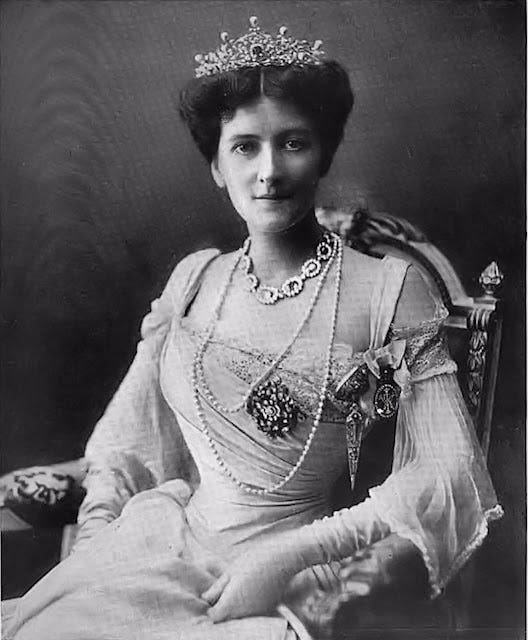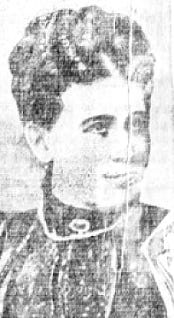Levi and Mary Leiter: Quintessential Parvenus and Buccaneers
The current site of the large International-style hotel at 1500 New Hampshire Avenue was once home to one of the largest and grandest mansions in Washington, built by Levi Ziegler Leiter (1834-1904).
Levi Ziegler Leiter was born in Leitersburg, Maryland (just north of Hagerstown) in the town founded by and named after his grandfather, Abraham Leiter. While some of his ancestors were Mennonites, Levi Leiter was raised as a Lutheran.
Leiter began working as a clerk in the village store in Leitersburg, but in 1855 at the age of 21 he moved to Chicago to work as a clerk in a dry goods store there. With a fellow employee, Marshall Field, Leiter bought an interest in the store and in 1865 sold it to go into business with Potter Palmer as Field, Palmer, Leiter & Co. In 1867, Palmer left the business and the company was renamed Field, Leiter & Co. Deciding to retire from the dry goods business, Leiter sold his interest in the company to Field in 1881, and the company name was changed to Marshall Field and Company. Marshall Field and Company survived until 2005, when it was acquired by Macy’s Inc.
Leiter developed an interest in real estate and invested heavily in the city, helping it to recover from the fire of 1871 and building his already immense fortune. While still in Chicago, he became associated with the Chicago School of architecture and was the builder of the first true steel skeleton building—the William LeBaron Jenney’s Leiter Building (1889). He also served as the second president of the Chicago Art Institute, provided a new building for the Chicago Historical Society, and donated generously to the Chicago Public Library.
Leiter married Mary Theresa Carver in 1866. Mary was the daughter of Benjamin Carver, a wealthy banker from Utica, New York and a descendant of John Carver, the first president of the Plymouth Colony. The couple had four children: Joseph, Nancy, Marguerite (Daisy) and Mary Victoria.
Like so many of the nouveau riche of that period, or parvenus as Mark Twain referred to them, the Leiters decided to establish themselves in Washington, DC. While not exactly born poor, Levi Leiter was considered a self-made man and Mrs. Leiter, was a former school teacher. Even in light of significant contributions to the city of Chicago, they would never fully be accepted by Chicago’s high society.
In 1883, the Leiters rented the Blaine mansion at 2000 Massachusetts Avenue for a whopping sum of $11,500 a year, the amount they were more than happy to quote to any who asked, or even didn't ask. People either gasped that they would pay that much, or more probably that they were so easily relieved of their money by Blaine. Either way, the rent allowed Blaine to comfortably relocate to Seward house on Lafayette Square and the Leiters to establish a foothold in Dupont Circle.
In 1891, the Leiters decided to move to Washington permanently and purchased a lot at 1500 New Hampshire Avenue, NW for $83,276.53 (again an astronomical price to pay for any real estate at that time). Undoubtedly, when folks saw Leiter coming, prices would likely skyrocket knowing that Leiter would never balk at any price asked.
Shunning the architects of Chicago and Washington, DC, Leiter chose Philadelphia architect Theophilus P. Chandler to design his own palatial mansion in DC. The original house was three stories plus basement, 55 rooms, 96’ across the front, 75’ deep, and 62’ in height and cost $125,000 to construct.
In the spirit of Edith Wharton’s The Buccaneers, all three daughters married high-ranking Englishmen, using the Leiter fortune to ensure their husband’s economic standing while at the same time boosting their own social standing in both Europe and the U.S. Mary Victoria married George, Lord Curzon, who became Viceroy of India. She would die in India in 1906, shortly after her arrival there. Daisy married the Earl of Suffolk, and Nancy married Colin Campbell, a colonel in the British army. The Leiters were well-traveled and took many trips abroad to visit their daughters.

Mary Leiter’s early attempt to enter Washington society was awkward at best. She quickly developed a reputation for comical malapropisms and social missteps. Upon returning from a trip to Europe, she was reported as saying that she “was relieved to set my feet on American terra cotta.” She was particularly proud of one acquisition and proudly showed guests “the bust of my daughter’s hand, done by Rodin.” At one of their dinners, Marguerite Cassini tried to refuse the terrapin soup. Mrs. Leiter screamed, “You can’t refuse my terrapin! It costs a hundred dollars!” But ultimately, Mary prevailed and became the leader of the smart set and their new grand mansion its center.
Upon his graduation from Harvard, Levi offered his son Joseph one million dollars to see what he could do with it. He soon had thirty million dollars’ worth of properties. But, he did make one large financial miscalculation. In 1897, he tried to corner the wheat market, but with concerted efforts by his competitors, the wheat market collapsed the following year. He lost at least ten million dollars and was bailed out of the debt by his father. By the time of his death, he was reportedly earning about one million dollars annually.
In 1904, Levi Leiter died of heart disease while vacationing at the Vanderbilt cottage in Bar Harbor, Maine, which the Leiters had taken for the summer season. He was interred in Rock Creek Cemetery, in Washington, DC.
Leiter requested a very particular way to be buried. Out of fear that his remains would be dug up by grave robbers and held for ransom, a 12-foot deep hole was dug with two feet of concrete poured in, then covered over with a grid of steel beams onto which the casket was lowered. More steel beams were bolted across the top of the casket before the entire chamber was then filled with concrete. Essentially, Leiter was completely encased in a steel-reinforced concrete block.

In 1909, Mary Leiter added a two-story brick addition to the rear (19th Street side) of the house and continued to live in the house and throw lavish parties there until her death in 1913. The house then passed to their son Joseph and his wife who occupied it until Joseph’s death in 1932. It was then left to Joseph’s son Thomas, with the provision that his mother be allowed to live there until her death. After she passed in 1942, the house was then leased to the U.S. Government for use as an office building. It was then sold in 1944 to Dupont Plaza, Inc. for $190,000, who razed it in 1947 to construct the current building on the lot, then an apartment building, and now a hotel.








